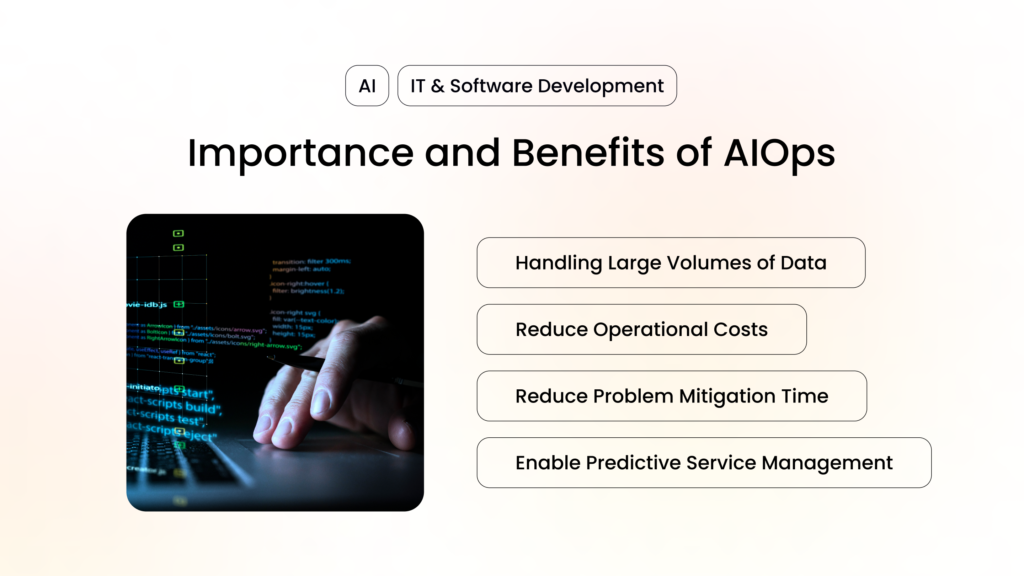In the rapidly evolving world of technology, the landscape of IT operations is undergoing a significant transformation. With the advent of AI-powered solutions, businesses are finding innovative ways to streamline processes, enhance efficiency, and stay competitive. This blog post will explore the concept of Artificial Intelligence for IT Operations (AIOps), its benefits, working mechanisms, and future prospects.
In today’s digital age, efficient IT operations are crucial for maintaining business continuity and fostering growth. From ensuring uptime to managing data, IT operations play a pivotal role in the smooth functioning of an organization. However, traditional methods often fall short in handling the complexity and volume of modern IT environments. Enter AIOps.
Introduction to AIOps
Artificial Intelligence for IT Operations, or AIOps, is an emerging field that leverages AI techniques to manage and optimize IT infrastructure. By automating critical tasks and providing real-time insights, AIOps is revolutionizing the way businesses approach IT operations.
AIOps involves using AI and machine learning (ML) techniques to automate and enhance various aspects of IT operations. It automates essential operational tasks such as performance monitoring, workload scheduling, and data backups, thereby reducing manual effort and minimizing the risk of human error.
The core technologies behind AIOps include machine learning, natural language processing (NLP), and advanced analytics, which work together to collect, analyze, and act upon data from various sources.
Importance and Benefits of AIOps

- Handling Large Volumes of Data
Ingesting, analyzing, and applying increasingly large volumes of data is a significant challenge for traditional IT operations. AIOps addresses this by utilizing AI to process and make sense of vast amounts of data efficiently.
- Reduce Operational Costs
AIOps helps in deriving actionable insights from big data, allowing lean teams to resolve issues efficiently. This, in turn, reduces operational costs and increases productivity.
- Reduce Problem Mitigation Time
By providing event correlation, real-time data analysis, and efficient root-cause analysis, AIOps significantly reduces the time taken to mitigate problems.
- Enable Predictive Service Management
Using historical data and ML, AIOps can anticipate and mitigate future issues, thus enabling predictive service management.

- Streamline IT Operations
AIOps aggregates information from multiple data sources, improving overall productivity and streamlining IT operations.
- Elevate Customer Experience
By analyzing customer behavior and preventing service disruptions, AIOps ensures optimal service delivery and enhances customer experience.
- Support Cloud Migration
AIOps seamlessly manages cloud infrastructures, improving observability and data management, thus supporting cloud migration efforts.
How Does AIOps Work?
- Observe Phase
In the Observe phase, AIOps intelligently collects data from the IT environment, improving observability across devices and data sources.
- Engage Phase
During the Engage phase, AIOps coordinates IT workloads, reducing dependencies on conventional IT metrics and alerts.
- Act Phase
In the Act phase, AIOps automates operational processes using analytics from ML algorithms to create automated responses.
Types of AIOps
Domain-Centric AIOps
Domain-centric AIOps involves AI-powered tools designed for specific scopes such as networking, application, and cloud performance.
Domain-Agnostic AIOps
Domain-agnostic AIOps offers scalable predictive analytics and AI automation across network and organizational boundaries.
AIOps Use Cases
Application Performance Monitoring (APM)
AIOps uses AI to gather and compile metrics at scale for modern applications, ensuring optimal performance.
Root Cause Analysis
By rapidly processing big data, AI/ML technologies in AIOps identify the true causes of system performance issues.
Anomaly Detection
AIOps provides real-time assessment and predictive capabilities to detect data deviations and automate remediation.
Cloud Automation and Optimization
AIOps supports cloud transformation by offering transparency, observability, and automation.
App Development Support
DevOps teams leverage AIOps tools to improve code quality and automate quality checks early in development.
AIOps Compared to Other IT Practices
- AIOps vs. DevOps
While DevOps bridges development and operations, AIOps uses AI to support IT processes, offering a more automated and intelligent approach.
- AIOps vs. MLOps
MLOps integrates ML models into products, whereas AIOps uses ML for actionable insights in IT operations.
- AIOps vs. SRE
Site Reliability Engineering (SRE) focuses on automating system operations. AIOps enhances this by using ML insights to reduce incident resolution time.
- AIOps vs. DataOps
DataOps optimizes data usage, while AIOps uses this data for incident detection and resolution.
The bottom line
In summary, AIOps is transforming IT operations by leveraging AI to automate tasks, provide real-time insights, and enhance efficiency. It plays a critical role in handling large volumes of data, reducing operational costs, and improving customer experience. While there are challenges in integration and skill requirements, the benefits and prospects make AIOps a crucial tool for modern enterprises.
For organizations looking to stay competitive and drive growth, adopting AIOps is not just an option – it’s a necessity. Explore the potential of AIOps and see how it can revolutionize your IT operations.







